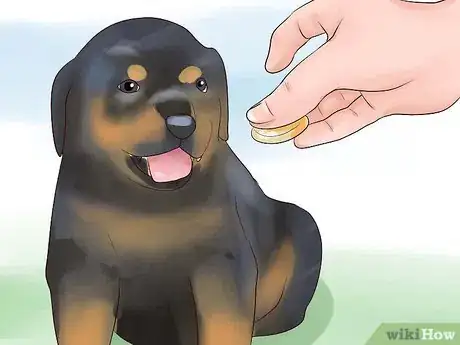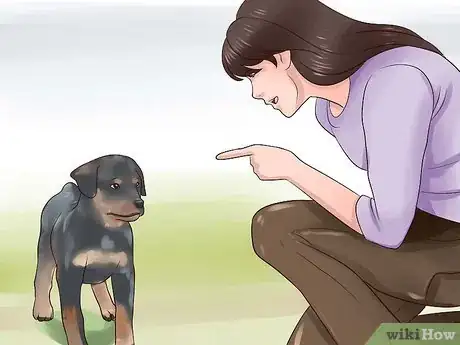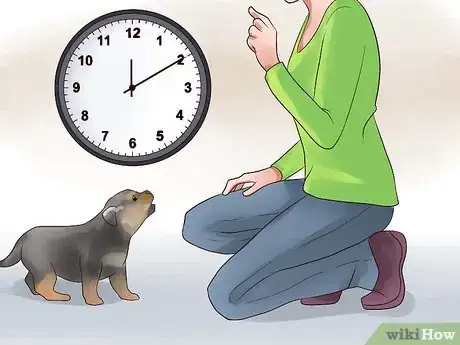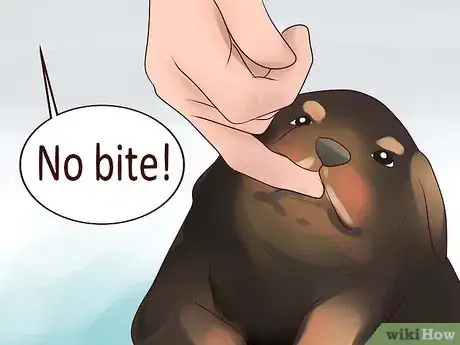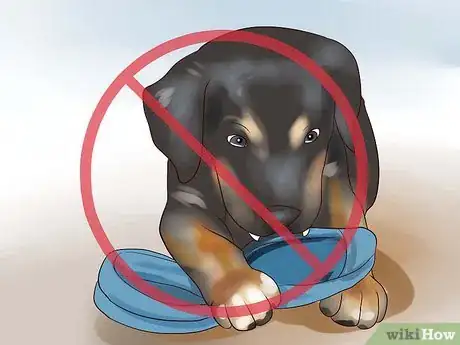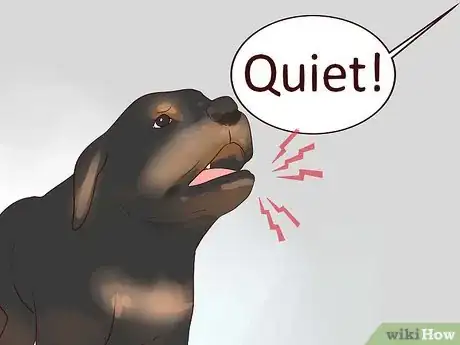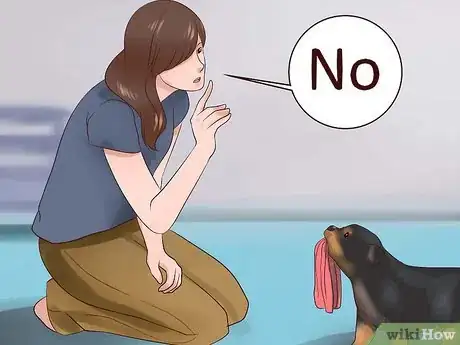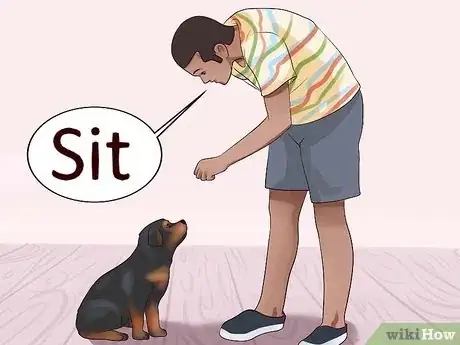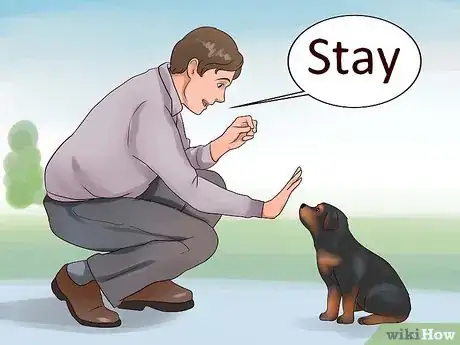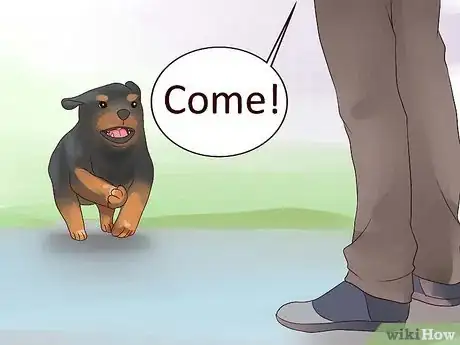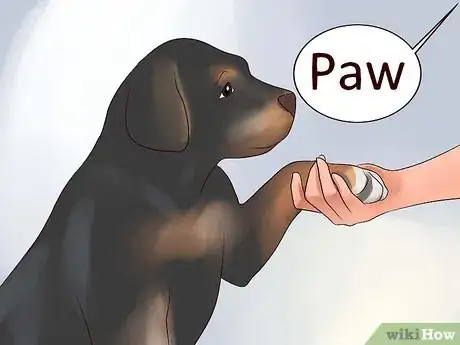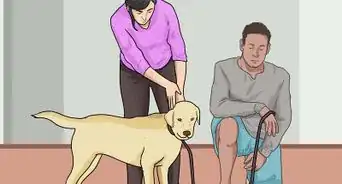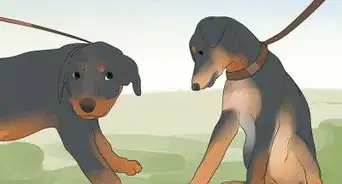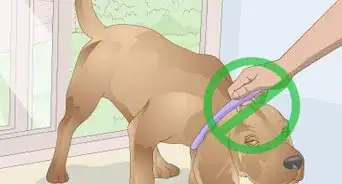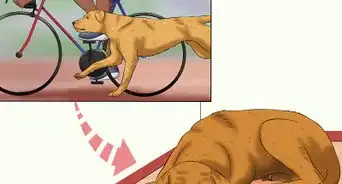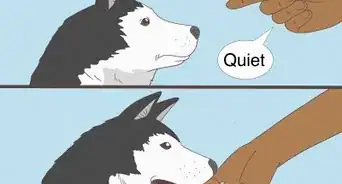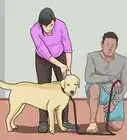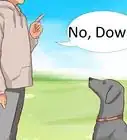This article was co-authored by Pippa Elliott, MRCVS. Dr. Elliott, BVMS, MRCVS is a veterinarian with over 30 years of experience in veterinary surgery and companion animal practice. She graduated from the University of Glasgow in 1987 with a degree in veterinary medicine and surgery. She has worked at the same animal clinic in her hometown for over 20 years.
wikiHow marks an article as reader-approved once it receives enough positive feedback. This article received 18 testimonials and 89% of readers who voted found it helpful, earning it our reader-approved status.
This article has been viewed 626,340 times.
Rottweilers are naturally loyal dogs and aim to please their owners. This loyalty, combined with their intelligence, makes them highly trainable.[1] A well trained dog is a happy dog as he knows his position in his human family. Investing a little time each day to training your Rottweiler puppy will help him adjust well to the family and make him a great canine citizen for years to come.
Steps
Understanding How Training Works
-
1Start early and short. Puppies can be taught simple commands starting at seven to eight weeks of age. The key to training is to make each session fun and short. A minute or two for each month of age up to 6 months is a good ballpark figure. Trying to do more than that will not benefit you or the dog because his attention span can’t handle it.[2]
-
2Reward your pet. Reward-based training is one of the most positive and effective way to train your Rottweiler puppy. Positive reinforcement, such as a small piece of a tasty treat or lavish praise, should be given immediately when the puppy obeys the command. Keep a bag of small, tasty treats handy, such as tiny cubes of cheese or very small pieces of cooked chicken, to immediately reward your pup for any steps towards learning the new command or cue.
- Once the puppy is consistently obeying your command, the treats can be given intermittently then gradually phased out, replaced with consistent praise.
- If you fail to reward immediately, the puppy will become confused as to what you expect from her or him.[3]
Advertisement -
3Learn the right kinds of commands. The commands used need to be short, one or at the most two words. Keep your voice friendly. Always praise your puppy for any attempt in the right direction, and absolutely never yell or hit your puppy. Your pup is obeying you because he wants to please you at this point, so remind him that he is pleasing you with his obedience.
-
4Be consistent. Each of these principles can be used for all the commands you use for training. The key to the reward system is to reward immediately, be consistent, and use simple command words. The best time to conduct a training session is when the puppy is relaxed and alert. Never train when the puppy is sleepy, wound up, or not feeling well. You want his mind completely on the training session and his attention on you.
-
5Train for the right amount of time. When you start training your dog, perform the commands for 10 to 15 minutes at a time. During this time period, spread out which commands you teach. Try five to 15 repetitions of one command, then move on to another one and do five to 15 repetitions of it. Once the time is over, reward your pet and praise him. You can do this up to three times a day with different commands.
- You should also start with shorter time periods he has to stay in each command as well. When you are first teaching him to sit, for example, try to make him sit for three seconds before rewarding him. As he learns, move the time up, increasing until he can stay for 30 seconds or longer.[4]
Teaching the Commands
-
1Teach ‘No bite’. The first training sessions should be to teach the puppy not to bite. You should have plenty of toys for your Rottweiler puppy on hand at all times. Puppies go through a teething stage and will bite your fingers or hand during play. If he does nip, say “No bite.” Play act that the puppy has hurt you, with mock yelping or squealing. After that, get up and leave. This gives the dog the message that biting ends the game. Avoid tapping a puppy on the nose as this will over excite him and make him more likely to bite.
-
2Command ‘No chew’. Chewing is a natural behavior for a puppy, but it can be destructive on a household. Diversion from an item you don’t want chewed to another you would rather the puppy chew on works well. For example, if you find your puppy chewing on a book, take the book away, put it out of reach, and give them a toy to chew on. As remove the book, say “no chew.” Your puppy will eventually understand what he can and cannot chew.[5]
-
3Tell him to be ‘Quiet’. You may want your puppy to bark when visitors or un-welcomed guests come to your home. However, your puppy should learn the command “Quiet” for those times when barking is a nuisance. Keep your bag of small treats with you at all times and when the puppy begins to bark, say “Quiet.” When the puppy hushes immediately, give him the reward so he associates the word “Quiet” with stopping barking.
- This may take some time, but he will eventually understand that you expect him to hush when you say quiet. Consistency and patience is the key in making this work for the both of you.[6]
-
4Teach ‘No’ or ‘Stop’. It is important for your dog to learn the meaning of 'no' or 'stop'. You can use either one, but the use of it must be consistent. Rottweiler puppies are very playful and love mouth items. If your puppy nibbles on you or things other than toys or picks up items he shouldn’t, it is very, very important for him to learn 'no!' or 'stop'.
- When teaching this to your puppy, always be firm and consistent. Once you have voiced the command, immediately move your dog away from whatever it is doing and once again say 'stop'. Walk away from your puppy, but don't take your eye off of him. If he goes back, repeat this process. This will be frustrating but you must do it. Otherwise, your puppy will grow up not knowing right from wrong. [7]
-
5Command ‘Sit’. After learning the “no” or “stop” command, you will want to teach your Rottweiler how to 'Sit'. Sitting makes grooming, feeding, playing, and relaxing much easier. It is also one of the easiest things to teach. Put a treat in your hand, letting the puppy see the treat. Have your puppy stand in front of you and firmly say 'sit'. Hold the treat on a level with the puppy's nose, then gently arc the treat backwards over his head. As he follows the treat with his nose to try and get it, his bottom will sink to the ground. Immediately say "Sit" to label the behavior he has just learned, and give the treat. It is good practice to have your puppy sit before placing his food down for him to eat. This teaches him ‘table’ manners.
- While he is sitting, shower him with praise, such as “good puppy” or “smart puppy”, while saying the word 'sit' a few times. Repeat this process by moving away from your puppy, turning to face him, making sure you have his full attention, and tell him to ‘sit’. Praise him as you did before.
- Work on the sit command for five to seven days until he is sitting promptly and consistently without the treat reward.[8]
-
6Tell him to get ‘Down’. Once he has learned to sit, you can teach him the ‘Down’ command. Put the puppy in the sit position while putting a treat in your hand. Make sure he knows you have the treat in your hand, and put your hand near his nose. While moving your hand to the floor say ‘down’ or ‘lay down’. The puppy will follow your hand to the floor by starting to lay down. As soon as he does, give the treat and praise him. He may make partial attempts at first, but he’ll get it.
- Practice this new command for up to a week until he has thoroughly learned it.
- The ‘Down’ command can be useful if your puppy is a jumper. Jumping on people can be a problem with puppies as they try to get your attention. If your puppy is a jumper, keep a leash on him to be able to correct him with ‘down’ as he starts to jump. Then give him the command to ‘sit’. Reward him when he promptly responds with a tasty treat. He will soon learn that jumping is not an acceptable behavior.[9]
-
7Teach ‘Stay’. Rottweilers will always want to be in your company. He will always want to be next to you, around you, or even on you. But he will eventually get in your way. Teaching your Rottweiler puppy to ‘stay’ keeps him from getting in the way of you, other people, and other dogs. Tell your dog to 'sit' first, as it is much easier to have him sit and allow him to ‘stay’. Once he sits, praise him and put your hand in front of his face, wide open like a stop sign. Firmly say 'stay', then back away slowly.
- He will most likely run up it to you, but have him sit again. Then put your hand in front of him once again, say 'stay', back away while all the while repeating ‘stay’. If he runs up to you, you will have to do it again. Once he stays, don't let him come to you. Instead, go to him, praise him, and give him a treat.
- Repeat this process while going farther away from him than you did the previous time until your puppy is consistently staying.[10]
-
8Tell him to ‘Come’. A very important command to learn is ‘come.’ If your puppy is ever running toward danger or in danger while away from you, a puppy that has a solid understanding of the ‘come’ command can be quickly recalled to your side. While your puppy is away from you, crouch down, slap your thighs and say ‘come’ in a friendly voice. No doubt your puppy will run to you eager to play with you. Reward him with a little treat and a bit of play.
- Work on this command at various times for a few weeks. If your puppy is far away from you, slap your thighs and say 'come' in an appealing, happy voice. Once he comes to you, praise him and repeat the word 'come' a few times. Then, throw a treat and or a toy far away from you and watch him run after it. Once he gets there, tell your dog to 'come' again. He might not do it at first, but you'll have to repeat it.
- If necessary, always have a treat or a toy that he loves more than the one you threw. Wave it to him once he looks up and say 'come!'. Once he comes over, praise and repeat. A little work and effort on your part will help your puppy retain this very important command.[11]
-
9Command ‘Paw’. Teaching your dog to 'paw' is also an easy and useful command. If you plan on clipping or filing your Rottweiler's nails, this is necessary. Have your puppy sit, then say 'paw' and reach down, take his paw in your hand and then praise and pet him. Repeat this process four times and then ask your dog to 'paw' without you lifting his paw. If he is able to do it, praise him and give him a treat.
- Paw is just as easy as ‘sit’ and it should not take long to learn.[12]
Expert Q&A
Did you know you can get premium answers for this article?
Unlock premium answers by supporting wikiHow
-
QuestionWho should train your Rottweiler puppy?
 Pippa Elliott, MRCVSDr. Elliott, BVMS, MRCVS is a veterinarian with over 30 years of experience in veterinary surgery and companion animal practice. She graduated from the University of Glasgow in 1987 with a degree in veterinary medicine and surgery. She has worked at the same animal clinic in her hometown for over 20 years.
Pippa Elliott, MRCVSDr. Elliott, BVMS, MRCVS is a veterinarian with over 30 years of experience in veterinary surgery and companion animal practice. She graduated from the University of Glasgow in 1987 with a degree in veterinary medicine and surgery. She has worked at the same animal clinic in her hometown for over 20 years.
Veterinarian
-
QuestionShould the treat be the same or different each time?
 Pippa Elliott, MRCVSDr. Elliott, BVMS, MRCVS is a veterinarian with over 30 years of experience in veterinary surgery and companion animal practice. She graduated from the University of Glasgow in 1987 with a degree in veterinary medicine and surgery. She has worked at the same animal clinic in her hometown for over 20 years.
Pippa Elliott, MRCVSDr. Elliott, BVMS, MRCVS is a veterinarian with over 30 years of experience in veterinary surgery and companion animal practice. She graduated from the University of Glasgow in 1987 with a degree in veterinary medicine and surgery. She has worked at the same animal clinic in her hometown for over 20 years.
Veterinarian
-
QuestionHow do I teach my Rottie to be more calm?
 Pippa Elliott, MRCVSDr. Elliott, BVMS, MRCVS is a veterinarian with over 30 years of experience in veterinary surgery and companion animal practice. She graduated from the University of Glasgow in 1987 with a degree in veterinary medicine and surgery. She has worked at the same animal clinic in her hometown for over 20 years.
Pippa Elliott, MRCVSDr. Elliott, BVMS, MRCVS is a veterinarian with over 30 years of experience in veterinary surgery and companion animal practice. She graduated from the University of Glasgow in 1987 with a degree in veterinary medicine and surgery. She has worked at the same animal clinic in her hometown for over 20 years.
Veterinarian
Warnings
- Never yell inappropriately at your dog. If you are training him and he doesn't fully understand, do not become impatient and scold him. He is only learning. Step away from him if you become frustrated and try again later.⧼thumbs_response⧽
- Never strike or hit your puppy. Hitting a puppy will make him fear and eventually resent you, damaging your bond with your dog. Walk away from the situation if you find yourself getting angry.⧼thumbs_response⧽
References
- ↑ http://www.akc.org/dog-breeds/rottweiler/
- ↑ http://www.vcahospitals.com/main/pet-health-information/article/animal-health/puppy-behavior-and-training-training-basics/229
- ↑ http://www.vcahospitals.com/main/pet-health-information/article/animal-health/puppy-behavior-and-training-training-basics/229
- ↑ https://www.aspca.org/pet-care/virtual-pet-behaviorist/dog-behavior/training-your-dog
- ↑ Canine and Feline Behavior for Veterinary Technicians and Nurses. Edited by Julie Shaw and Debbie Martin. John Wiley & Sons, Inc. 2015
- ↑ Behavior Problems of the Dog and Cat 3: Behavior Problems of the Dog and Cat. G.M. Landsberg, W. L. Hunthausen and L. J. Ackerman. Elsevier. 2013
- ↑ Behavior Problems of the Dog and Cat 3: Behavior Problems of the Dog and Cat. G.M. Landsberg, W. L. Hunthausen and L. J. Ackerman. Elsevier. 2013
- ↑ Behavior Problems of the Dog and Cat 3: Behavior Problems of the Dog and Cat. G.M. Landsberg, W. L. Hunthausen and L. J. Ackerman. Elsevier. 2013
- ↑ Behavior Problems of the Dog and Cat 3: Behavior Problems of the Dog and Cat. G.M. Landsberg, W. L. Hunthausen and L. J. Ackerman. Elsevier. 2013
- ↑ Handbook of Applied Dog Behavior and Training, Procedures and Protocols. Volume 3. Steven R. Lindsay. Blackwell Publishing. 2005
- ↑ Handbook of Applied Dog Behavior and Training, Procedures and Protocols. Volume 3. Steven R. Lindsay. Blackwell Publishing. 2005
- ↑ Handbook of Applied Dog Behavior and Training, Procedures and Protocols. Volume 3. Steven R. Lindsay. Blackwell Publishing. 2005
About This Article
To train your Rottweiler puppy, start training sessions when your puppy is about 8 to 10 weeks old. Then, begin with one word commands, like "sit" or "quiet." If you want to teach your puppy to stop doing something, say "stop" before moving it away from the object it's playing with. Make sure to have your training sessions when your puppy is relaxed and alert so that it can focus on what you're saying. Additionally, keep sessions to 10 minutes in length to start with so that your puppy doesn't get bored or distracted. For tips on how to train your puppy to sit and why it's important to reward good behavior, read on!

